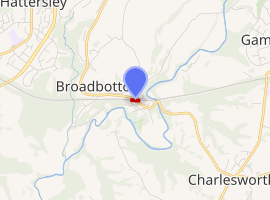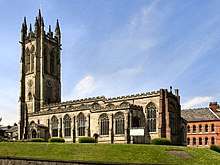Broadbottom Viaduct
Broadbottom Viaduct (also known as Etherow or Mottram Viaduct) is a railway viaduct that spans the River Etherow between Derbyshire and Greater Manchester in England. Originally of wooden construction supported by stone piers, the timber was replaced first with wrought iron girders, less than 20 years after the viaduct's opening, and later with riveted steel girders.[1][2]
Broadbottom Viaduct | |
|---|---|
 The central section, showing one of the original stone piers and one of the 20th-century red brick intermediate piers | |
| Coordinates | 53.440794°N 2.006548°W |
| Carries | Glossop Line |
| Crosses | River Etherow |
| Locale | Broadbottom, Greater Manchester, England grid reference SJ997938 |
| Other name(s) | Etherow Arches |
| Maintained by | Network Rail |
| Characteristics | |
| Total length | 169 yards (155 meters) |
| Height | 136 feet (41 meters) |
| History | |
| Architect | A.S. Jee |
| Designer | Joseph Locke |
| Opened | 1842 |

| |
History and design
Broadbottom Viaduct is one of two similar viaducts 1.5 miles (2.4 kilometres) apart (the other being the much longer Dinting Viaduct) on the Glossop Line, which connects several villages in north-west Derbyshire with Manchester Piccadilly station. Both viaducts are significant for their height and the distance between their columns. Broadbottom is 137 feet (42 metres) high, 169 yards (155 metres) long, and has three main spans, which carry the railway over a gorge formed by the River Etherow.[1]
Built by Joseph Locke and A.S. Jee for the Sheffield, Ashton-under-Lyne and Manchester Railway,[1] the foundation stone of Broadbottom Viaduct was laid by John Chapman on 17 February 1842. Then on 10 December that same year trains ran from Godley to Broadbottom.[3]
The viaduct itself was originally of a laminated timber construction with three arches, each having three ribs, of which the middle rib was considerably heavier than the other two. The timberwork deteriorated, and was replaced with hollow wrought iron plate girders which were fabricated on-site by contractors William Fairbairn & Sons while the viaduct continued in use. The girders were carried onto the bridge on bogies before being lowered onto the existing supporting piers, built from locally quarried stone. The work was completed by the end of 1859 after a little over six months; similar work carried out on Dinting Viaduct was completed in 1860, having had minimal effect on train services.[1] Railway historian Gordon Biddle described the wrought iron construction as "less majestic" than the original, but "still impressive".[1]
At some point, the wrought iron girders were replaced with riveted steel girders.[2] Further remedial work was carried out in 1919; by then, the weight of modern trains necessitated the strengthening of Broadbottom and Dinting viaducts. Three red brick intermediate piers, of which one is in the river, were built to better support the girders.[1]
See also
| Wikimedia Commons has media related to Broadbottom Viaduct. |
References
- Biddle, Gordon. Britain's Historic Railway Buildings: A Gazetteer of Structures (Second ed.). Hersham, Surrey: Ian Allan Publishing. pp. 292–293. ISBN 9780711034914.
- Ashmore, Owen (1982). The Industrial Archaeology of North-west England. Manchester: Manchester University Press. pp. 85–86. ISBN 9780719008207.
- "Viaduct is still on track". Manchester Evening News. 15 March 2012.

